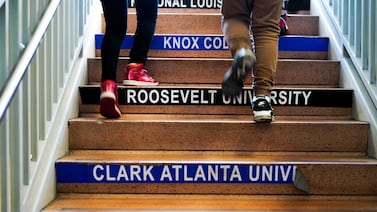Sign up for Chalkbeat Colorado’s free daily newsletter to get the latest reporting from us, plus curated news from other Colorado outlets, delivered to your inbox.
Slashing chronic absenteeism rates, boosting third grade reading scores, and ensuring high school graduates earn college credit or work experience alongside their diplomas are among the Colorado Department of Education’s new strategic goals.
The department has set five “wildly important goals” it aims to achieve over the next several years. Other state agencies, including the Colorado Department of Early Childhood Education, are setting similar goals. Together, they represent some of the state’s biggest public policy priorities.
Education Commissioner Susana Córdova said her department’s goals are meant to address some of the 880,000-student system’s thorniest challenges.
“Schools continue to face pandemic-related challenges including poor attendance, teacher shortages, and learning loss,” she told the Colorado State Board of Education last month.
Here’s a look at three of the department’s goals and the state’s progress toward meeting them.
Reduce chronic absenteeism
Goal: Cut chronic absenteeism to 15% of K-12 students by the 2027-28 school year.
Progress: In the 2023-24 school year, 27.7% of students were chronically absent.
A student is considered chronically absent if they miss 10% or more of the school days in a school year, or approximately 18 days. Chronic absenteeism is a problem because students who miss a lot of school can fall behind academically and find it hard to catch up.
“If they’re not there, I don’t care how great your instruction is, how great your building is, how many programs you have,” State Board of Education member Lisa Escárcega said at a meeting this week while discussing the goals. “If they’re not there, they can’t learn.”
Chronic absenteeism has always been an issue, but it was made worse by the pandemic. Schools across the country have struggled to improve student attendance in the years since. While some are seeing success, absenteeism rates largely remain higher than they were before COVID.
That’s true in Colorado. The state’s chronic absenteeism rate hit a high of 35.5% in the 2021-22 school year. It was a huge jump from before the pandemic, when the rate ranged from 18% to 24%.
Colorado is one of several states that have signed on to an ambitious pledge to cut chronic absenteeism by half over a five-year period. The department’s goal of a 15% chronic absenteeism rate would be a big improvement on the pre-pandemic rate.
The department has already launched a statewide campaign called “Every School Day Matters!” According to the website, more than 30 districts and schools have signed on. The department hopes 80% of Colorado’s 178 districts will agree to participate by next October.
The department also aims to increase training for educators and grow the number of visitors to a website with guidance and resources for school staff on how to foster a sense of student well-being and belonging in their schools — an element that students say is important.
Increase third grade reading scores
Goal: 60% of third graders will meet or exceed state expectations in literacy by 2028.
Progress: In 2024, 42% of third graders met that bar on the state literacy test.
Third grade is considered a key year for reading. Some studies have shown that students who can’t read proficiently by third grade are less likely to graduate from high school.
Colorado tests students in grades 3-11 in reading, writing, and math each spring. The tests for third graders are called Colorado Measures of Academic Success, or CMAS.
Student test scores plummeted during the pandemic and are now climbing back up. Colorado’s third grade reading scores were actually slightly higher in 2024 than they were in 2019 before the pandemic. But state officials say the state still has work to do.
State Board of Education members emphasized the importance of helping students early.
“I’ve heard teachers say, ‘Don’t worry about your kid. They’ll get it later on. It’ll come to them,’” said board member Angelika Schroeder. “Folks, it doesn’t come to a lot of kids.”
Colorado has never come close to 60% of third graders meeting or exceeding expectations in literacy since it rolled out the CMAS tests in 2015. Córdova called this goal “very ambitious.”
To get there, the department plans to offer more training to educators and ensure more school districts are using what it calls “high quality instructional materials.”
The department also plans to redesign its awards to “celebrate schools with strong results.”
Boost postsecondary readiness
Goal: 100% of the Class of 2029 will have earned 12 college credits, a non-degree credential, or participated in a work-based learning opportunity.
Progress: The state doesn’t currently track this metric in this way.
Colorado has for several years been focused on a concept called the “big blur,” which refers to blurring the line between high school and students’ next steps. At its simplest, it’s an attempt to better prepare high school graduates for college or the workforce.
Dual enrollment programs, which allow students to take college-level classes in high school, have become wildly popular. Dual-enrolled high school students now account for nearly half of the students at Colorado’s community colleges.
But most dual-enrolled students leave high school with only a few college credits. The department wants to drastically increase that number.
Officials also want to increase the number of students earning non-degree credentials that would allow them to work in high-demand fields, such as health care or early childhood education.
And they want to boost the number of students participating in apprenticeships, on-the-job training, internships, and other work-based learning experiences.
Colorado has a host of programs meant to accomplish these goals. But the system is fragmented and confusing, with different programs overseen by different departments. The programs also have differing amounts of funding from the state and buy-in from school districts.
A new report commissioned by state lawmakers includes recommendations for improvements, some of which may be taken up by policymakers in the upcoming legislative session.
The department also wants to increase the number of school districts participating in training sessions about postsecondary workforce readiness and the number that are including postsecondary workforce readiness strategies in their required improvement plans.
Melanie Asmar is the bureau chief for Chalkbeat Colorado. Contact Melanie at masmar@chalkbeat.org.





